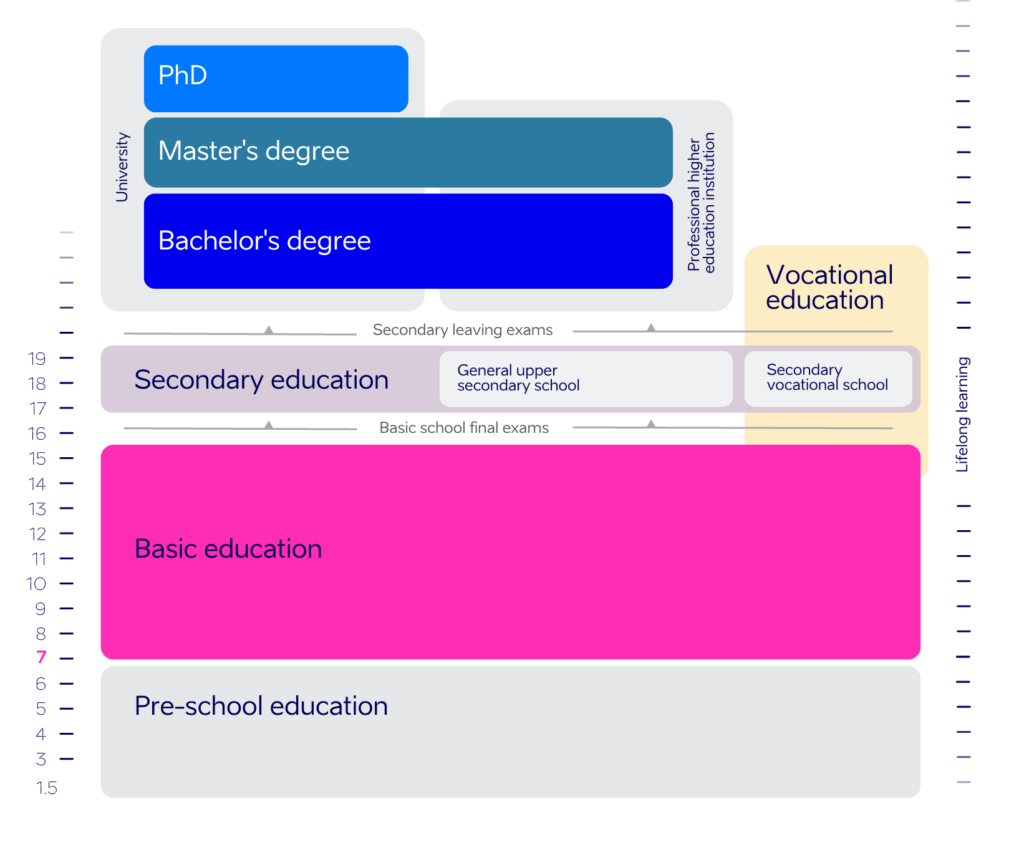The history of formal education in Estonia dates back to the 13th and 14th centuries when the first monastic and cathedral schools were founded. By now, Estonia has combined a belief in learning with equal-access technology to create one of world’s best education systems. PISA tests have shown that Estonia has also been successful in increasing equity in education – here, everyone has access to high-quality education.
Estonia follows a comprehensive school system that aims to provide all students with the best education, regardless of their background.
Schools in Estonia enjoy quite extended autonomy. The national curriculum leaves space for the school to develop their own curriculum. All schools can decide on their goals and the focus of studies. Principals can hire and fire teachers, decide on how to allocate the budget and evaluate the needs for teacher training. Teachers decide on the appropriate textbooks and teaching methods they would like to use in their lessons.
In Estonia, education is free by law unless parents opt for private schools for their children. Apart from free services, such as lunch, textbooks, and school transport, students get support services if needed.
The length of the study period consists of at least 175 teaching days (35 weeks) and four intervals of school breaks.
According to the child’s interests, the child may also be enrolled in a hobby school.
Pre-school education is delivered to children between the ages of 18 months to 7 years in specially dedicated educational institutions.
In Estonia, pre-school education is not only childcare but also part of learning with a curriculum and substantive and methodological activities.
Although children start school at a relatively late age of 7, many of the activities that in other countries are done at school, Estonian children do in kindergarten in a more playful and relaxed environment. Most children know how to read and write when they start first grade at school.
94% of 4- to 7-year-olds participate in the activities of pre-school institutions.

Compulsory basic education lasts from grades 1 to 9. Parents are free to select a school for a pre-school-age child. Every child has the right to receive basic education at a nearby school. The principles of inclusive schooling are implemented, meaning that students with special educational needs usually study in an ordinary class of their school.
⦁ Acquisition of basic education grants the right to continue studies to acquire secondary education.
⦁ Graduating the basic school requires that the student learns the curriculum at least a satisfactory level together with passing three basic school graduation exams, consisting of the Estonian language, mathematics and an exam on a subject of the student’s choice, as well as completing a creative assignment.
General secondary education is acquired at the upper secondary school level. Upper secondary schools are designed to help students become creative, multi-talented, socially mature and reliable citizens.
⦁ The study programme at upper secondary school is arranged into mandatory and voluntary courses. Studies last for 3 years.
⦁ To graduate, students must complete a curriculum consisting of 96 individual courses as a minimum.
⦁ At the end of their studies, students must pass three state exams (Estonian, mathematics and a foreign language), school examination and student study or practical work.
⦁ Attaining general secondary education entitles students to continue their studies at a higher educational institution or to obtain vocational education.
Vocational education serves the purpose of fostering the knowledge, skills and attitudes, occupational know-how and the social readiness required for working, participating in social life and participating in the lifelong learning process. Vocational education is free and can be obtained after basic school as vocational secondary education (length: 3-4 years) or as vocational skills only without general education (length: 3 months to 2.5 years).
There are close collaborations with companies in curriculum development and in creating opportunities for apprenticeship. Moving from vocational education to higher education and vice versa is becoming increasingly popular.
For a more detailed overview, you can find more information on our vocational education page.
Higher education is flexible and accessible. It is supported by a wide range of study forms, consideration of learning and work experience in studying, and the opportunity to work during studies. For a comprehensive overview of higher education in Estonia, see Study in Estonia.
See the Research Estonia website to get an overview of the research and development carried out by universities and other public and private sector institutions.
In the spring of 2020, digital technology helped to continue learning and teaching in Estonia. However, the unavoidable prerequisite to use any e-solution is a good internet connection and in order to use technology successfully, we need digital competence, ie the ability to solve problems with the help of digital technology. Read more on e-solutions used in education, how Estonia supports the digital competence of teachers and students, the development of the digital infrastructure and the policy of digital devices in Estonian schools.
The Republic of Estonia contributes 6.4 percent of GDP on education (Eurostat, 2020).
According to the Basic Schools and Upper Secondary Schools Act, the school’s running costs will be covered by the school manager. In most cases, this means local governments. The number of the students in municipal schools will be used to calculate the amount of state subsidies allocated from the state budget to municipalites. The state subsidy is used for covering expenses on teachers’ salaries, social taxes, training and textbooks. 1% of school’s payroll budget goes to teacher training.
Similar subsidies are also made available to private general education schools (11% of all schools in Estonia).
Preschool institutions are mostly municipally owned and they are therefore financed from the budget of the local government. Parents also participate in covering the costs.
Get our newsletter
Subscribe to the Education Estonia newsletter